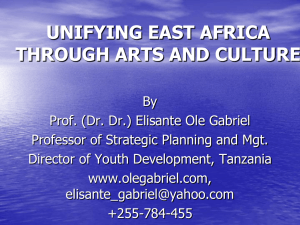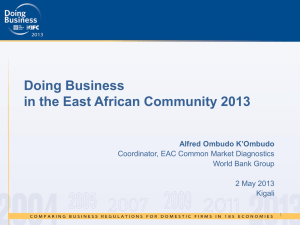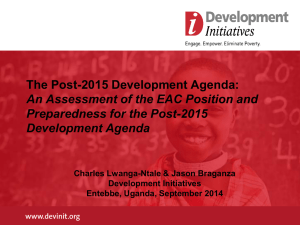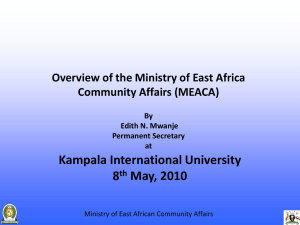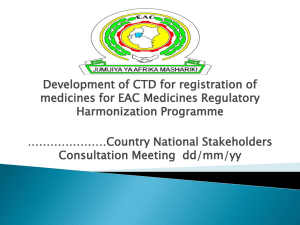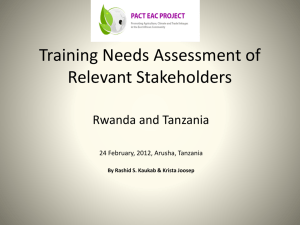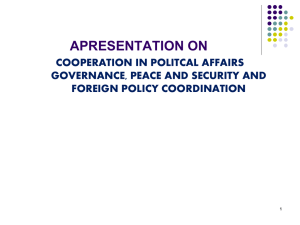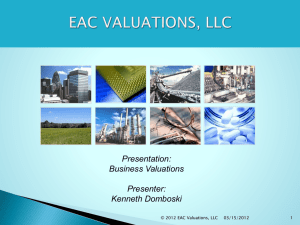AN OVERVIEW OF EAC -NYERERE CENTRE
advertisement
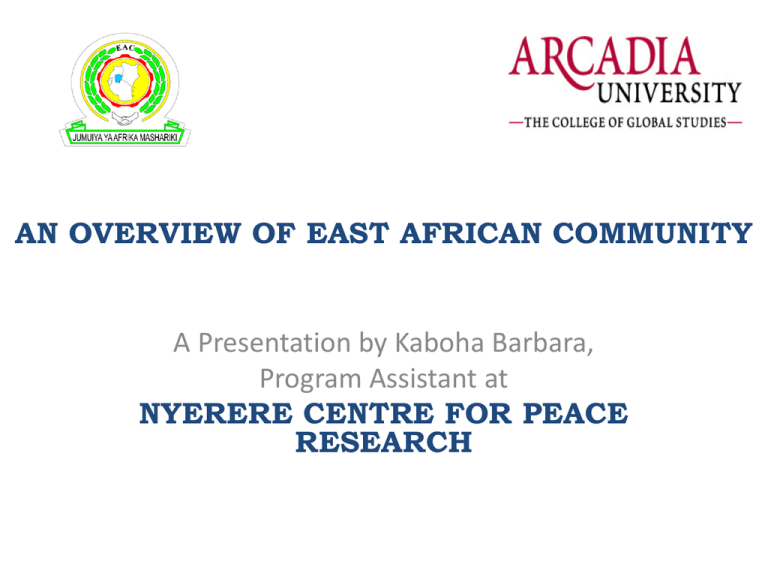
AN OVERVIEW OF EAST AFRICAN COMMUNITY A Presentation by Kaboha Barbara, Program Assistant at NYERERE CENTRE FOR PEACE RESEARCH INTRODUCTION East African Community: Inter-government Organization Comprising the Republics of Burundi, Kenya, Rwanda, Uganda and the United Republic of Tanzania. The EAC was originally founded in 1967, collapsed in 1977, and was revived 1999 when the treat for its established was signed and it came into officially on July 7th 2000. Causes for the collapse included; Demands by Kenya for more seats than Uganda Tanzania in decision-making organs, Disagreements with Ugandan dictator Idi Amin, The unequal economic systems of socialism in Tanzania among others. • The three member states lost over sixty years of co-operation and the benefits of economies of scale. • And each of the former member states had to embark, at great expense and at lower efficiency, upon the establishment of services and industries that had previously been provided at the Community level. • • • • EAC’s VISION: To have a prosperous, competitive, secure and Politically united East Africa’’ MISSION: “To widen and deepen economic, Political, social and cultural integration in order to improve the quality of life of the people of East Africa through increased competitiveness, value added production, trade and investment” STAGES OF EAC INTEGRATION • Customs Union; to enhance efficiency of production; A fully fledged Customs Union was established on 1st January, 2010, after five years of transitory implementation; • Common Market; aims at promoting economic growth and development; it provides for free movement of persons, capital, goods, services, and the rights of residence and establishment. it came into force on 1st July, 2010; • Monetary Union; aim is to easy the economic transactions; Negotiations for the Monetary Union have commenced and it is expected that they may be concluded by early 2013; • Political Federation; to enhance peace and security, good governance and foreign policy the processes and initiatives to lay its foundation are ongoing. EAC ORGANS 1. The Summit; comprises of Heads of partner States and they give the direction of realization of EAC goals and objectives. 2. The Council of Ministers; main decision making organ made up of ministers responsible for EAC Affairs/cooperation from Partner States. 3. The Coordinating Committee; comprises of permanent secretaries and its responsible for regional cooperation and coordination of activities of the sectoral committees. 4. Sectoral Committees; comprises of senior officials responsible for monitoring of programs and their implementation by directed by council and are elected by coordination committee. 5. The East African Court of Justice; ensues that community law is interpreted and implemented with in the treaty. 6. The EAC Secretariat; executive organ of the community that ensures regulation and directives are adopted by council are properly implemented. 7. East Africa Legislative Assembly; debates and approves the EAC budget among others functions. INSTITUTIONS OF EAC • Lake Victoria Basin Commission (LVBC) is responsible for coordinating the sustainable development of the Lake Victoria Basin shared by Kenya, Tanzania and Uganda. • The East African Community Civil Aviation Safety and Security Oversight Agency (CASSOA); responsible for ensuring the development of safe and secure civil aviation system in the region. • Inter-university Council for EA(IUCEA); among its objectives is to Facilitate networking, promoting competitiveness in higher education among universities in East Africa and outside the region. • Lake Victoria Fisheries organization(LVFO); aim is to harmonize, develop and adopt conservation and management measures for the sustainable utilization of living resources of Lake Victoria to optimize socio-economic benefits from the basin for the three Partner States. • EA Development Bank(EADB); development finance institution with an overriding objective of promoting development in the Member States, EADB plays a threefold role of lender, advisor and development partner. The Bank provides a range of products and services which are tailor made for the region's development requirements. ORGANISATIONS WITH OBSERVER STATUS IN EAC 1. East African Business Council 2. East African Trade Union Council 3. East African Centre for Constitutional Development( Kituo Cha Katiba) 4. East African Law Society 5. East African Book Development Association 6. East African Magistrates and Judges Association. Political Federation Dept: The objective of the PF department is to enhance Peace and Security, Good Governance, Rule of Law, and respect of Human Rights through the processes and initiatives to lay a foundation for a Political Federation. Political Federation Departments/units include; 1. 2 3 Political Affairs Dept: Promote Political Integration, and develop policies and structures for the establishment of the Political Federation; International Relations Dept; enhance bilateral, multilateral and inter EAC negotiations and fulfill statutory obligation to regional and international organizations. Peace and Security Dept; promote defense, peace and security as a basis for good neighborliness. Where the EACNCPR is most incorporated. PILLARS OF POLITICAL INTEGRATION AND LAYING THE FOUNDATION Protection of human rights: i) Institutionalisation of the EAC Forum of National Human Rights Commissions. ii) EAC Regional Plan of Action includes activities for national human rights commissions iii) Development of the EAC Bill of Rights / model law for protection of human rights. EALA has passed the EAC Bill of Rights – a positive move if assented by Partner States. iv) Enhancement of jurisdiction of the East African Court of Justice to include Human Rights. Anti-corruption, Ethics and Integrity: i) Corruption is one of the non tariff barriers to regional integration ii) Marketing the EAC as a single tourist destination,investment and trade zone; to negotiate as a bloc in international fora calls for high levels of integrity, transparency and accountability iii) A protocol on preventing and combating corruption is under LAYING THE FOUNDATION CONT.. development; it covers asset recovery and forfeiture, transfer of criminals and criminal proceedings; iv) Provides for extradition, judicial cooperation and mutual legal assistance and establishes Financial Intelligence units Promoting Democracy i) Election is one of the key tools towards upholding good governance and democracy BUT is also a source of expensive conflicts within the Eastern African region. Establishment of the EAC Forum of National Electoral Bodies. iii) Constitute electoral support and Electoral Observation missions to the Partner States’ elections - ongoing iv) Development of EAC Policy on election observation and Evaluation: ongoing v) Study on reduction of electoral costs and sharing electoral equipment : not yet commissioned vi) Piloted a joint election observation mission with sister RECs – led to wider coverage and more credible assessment – innovative idea that could be developed further in consultation with EALA LAYING THE FOUNDATION CONT.. The Rule of Law and Access to Justice: i) The sector promotes enactment of just laws based on common benchmarks; and ii) facilitates effective administration of justice systems in a manner that guarantees social justice, prevention of conflicts, peace and political stability. EAC Forum of Chief Justices: i) Centrality of the judiciary especially on issues of governance, upholding the rule of law, constitutionalism and access to justice. ii) EAC Forum of Chief Justices is established iii) Brings together all EAC Chief Justices to share experiences, challenges and best practices for the region. Annual EAC Conference on Good Governance – Brings together all pillars of the Good Governance Programme i) Inter-agency cooperation and capacity building – brings together all sectors in the promotion of human rights, laws enforcement. LAYING THE FOUNDATION CONT.. Research and Publication of EAC occasional papers – To promote dialogue and continuous debate on core issues in political integration. The 1st series was published and launched in 2011, while the 2nd series are at final stages for publication. EAC Dialogue on Political Integration Brings together key stakeholders to discuss topical issues related to Integration. Regional meeting of Political Parties A fundamental stakeholder in democracy and good governance. Development of a protocol on good governance Developing an EAC Specific Governance Review Mechanism – and the anti-corruption assessment mechanism. FOREIGN POLICY COORDINATION The main objective of the sector is to initiate measures aimed at developing a cohesive force in the management of the EAC’s international relations through: i) harmonizing Partner States’ common foreign policies. ii) Coordinate implementation of strategies establishing systematic cooperation between the EAC and the International Community RECs, AU, EU, UN, etc. iii) strengthening engagement of the Partner States Diplomatic Missions in the pursuit of the Community’s objectives. iv) support for East Africans to access jobs of influence in the international system v) mobilizing other countries and sub-regional/international organizations to support EAC integration objectives. vi) This cooperation is based on the MOU on foreign policy coordination (now upgraded into a Protocol that is awaiting ratification) Peace and Security sector a) b) c) d) Peace and Security is a prerequisite for the EAC integration and economic development. Cooperation in the Sector is currently guided by the Strategy for Regional Peace and Security as adopted by the 13th Meeting of the Council of Ministers The Strategy identifies 15 areas of cooperation which the Peace and Security Department has been activating on incremental basis. Cooperation in Policing including joint operations to curb motor vehicle theft, disarmament, smuggling and exchange of offenders. So far cooperation in the following areas have been activated: i) Counter terrorism; Policing and crime management iii) Prisons and Correctional Services and Intelligence sharing; iv) Disaster Preparedness and Management; v) Refugee Management; among others vii) Fighting small arms; Countering piracy; ix) Countering cattle rustling. Peace and Security sector Cont… Development of an Early Warning Mechanism and Conflict Prevention Management and Resolution are well advanced and are awaiting the conclusion of the Peace and Security Protocol to facilitate implementation. At an advanced stage of conclusion is the Peace and Security Protocol that besides facilitating the operationalization of the Peace and Security Directorate, will also operationalise: - i) framework on conflict prevention, management and resolution (CPMR) ii) Conflict Early warning iii) EAC Panel of Eminent Persons to perform track two diplomacy for the region. PEACE AND SECURITY SECTOR CONT… h) The EALA session passed a Bill of CPMR which once assented to by the Partner States, the Department will develop modalities for its implementation. i) Cooperation arrangements are also being concluded with other Regional Organizations with Peace and Security Mandate in the Region to enhance synergies and avoid duplication a) CONFLICT PREVENTION MANAGEMENT AND RESOLUTION (CPMR) Potential conflicts within the Partner States and among the Partner States require a mechanism for peaceful resolution of disputes/conflicts; b) need for a mechanism under which EAC can respond to conflict situations and participate in their resolution; c) Envisage establishment of a panel of eminent peace negotiators and envoys to assist in peace negotiations in the region; CHALLENGES Regional integration is a political process; EAC is a political organization whose decisions are political and require political will to implement. b) Political integration and governance issues are sensitive and require even higher levels of political will. c) Sovereignty - Political dynamics are dictated by the sovereign nature of Nation States; need to cede some sovereignty to supra national institutions at regional level. d) Disparities in the Partner States’ governance structures and practices, which is the foundation for a central decision making mechanism, impact negatively on the integration agenda Decision making by consensus means the pace of integration is dictated by the slowest member. f) Lack of a regional monitoring and follow up mechanism to enforce implementation of decisions and policies by Partner States. g) Absence of practical ramifications / penalties / sanctions for non implementations of decisions / policies by the Partner States. h) Absence of a specific Sectoral Council to handle Political Affairs matters has contributed to slow pace in decision making for the respective sector. OPPORTUNITIES a) b) c) e) f) g) EAC enjoys immense political will from the region’s political leadership. EAC has embarked on a holistic approach to integration covering all sectors. Most of the fears, concerns challenges to political federation have been addressed by the Customs Union Protocol, the Common Market Protocol and the negotiations towards the Monetary Union. The EAC Partner States have in principle adopted the AU-NEPAD Peer Review Mechanism for self assessment in governance matters. Development of a suitable EAC Governance Assessment Mechanism that takes into account the regional context to consolidate governance in East Africa. Key organs of the Community, pertinent to political integration are already in place i.e. EALA and EACJ - need strengthening. EAC- NYERERE CENTRE FOR PEACE RESEARCH The centre is a functional unit with in the Political Federation department and It was launched on 13th July 2007. Its establishment was inspired by the legacy of peace by the Late Mwalimu Nyerere, former President of the United Republic of Tanzania. The choice to host this Centre in Arusha was inspired by the city’s history as a hub for peace negotiations in the region Vision: • Is to become a global center of excellence for peace and conflict research. Mission: • Is to build capacity in conflict prevention, mitigation and Resolution through research and training. Overall Objective • The overall objective of the Centre is to provide the EAC with relevant and timely research, training and information that contribute to deepening and widening of integration especially in areas under cooperation in political matters including peace and security, good governance and foreign policy coordination. OBJECTIVES OF NCPR 1. 2. 3. 4. To promote peace and security as a means to further regional integration and development and establish an onsite research facility in support of: regional peace and conflict resolution and regional capacity building. To undertake research on common policies for the management of refuges. Early warning systems and development of appropriate mechanism for conflict management and resolution. To establish a regional facility for research and data collection, training and information dissemination in the peace and security sector. To develop projects associated with the strategies identified by the parties to promote the peaceful resolution of disputes and conflict amongst the Partner States. • • • • • • ACTIVITIES OF NCPR It carries out research; in areas of peace and security matters. Capacity building; training programs in peace and conflict management, good governance and foreign policy. Students exchange programs/internship with Arcadia to educate and sensitize students on EAC integration. PARTNERSHIP WITH ARCADIA EAC-NCPR in collaboration with Arcadia University offer Undergraduate and Graduate students exchange programmes on Conflicts, Peace and Security in East Africa; Human Rights in Africa. NCPR and Arcadia offers scholarships to EAC students to attend the exchange programmes at the Secretariat covering program related expenses and tuition fees. These programmes run three times in a year, Early February to May under graduates, June to July-graduates, August to December-undergraduates. END
